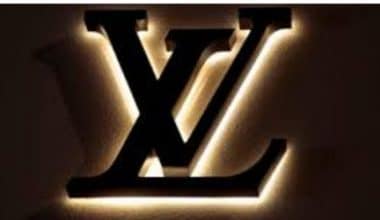Mazda is a Japanese automobile manufacturer, founded in 1929 in Hiroshima by Jujiro Matsuda. In 1931, the business unveiled its first vehicle. It is now one of the world’s top 15 automakers by volume, as well as one of the most popular automobile manufacturers in Asia and Russia. In this article, we’ll discuss the history and evolution of the car brand’s most important identity: The Mazda Logo
History and Significance of The Mazda Logo
The brand’s name is derived from the name of its creator, Jujiro Matsuda, which is pronounced Mazda in Europe. But it also has another meaning: Ahura Mazda is a god of harmony, wisdom, and illumination in Asian cultures. Because the brand’s creator was a deeply spiritual guy, the Mazda name and logo are thought to contain a plethora of hidden meanings.
During its early years, the company concentrated on the production of tools and heavy machinery. As a result, the logo for the initial brand was straightforward and simplistic.
Evolution of The Mazda Logo
1920 – 1928
The first Mazda logo was introduced in 1920 and remained with the well-known Japanese company for eight years. It was a strong abstract geometric insignia with bold black lines on a white backdrop. The round shape of the logo was inspired by shuriken, one of the most well-known ninja weapons.
1928 – 1931
The 1928 redesign featured a minimalist red and white badge with a clean flawless circular shape and two thick horizontal lines emerging from the red border to the center of the badge. The lines’ ends were quite separated from one another.
1931 – 1934
The Mazda logo, designed in 1931, featured the iconic Mitsubishi diamond emblem, which was made up of three rhombuses joined by the corners to form a triangle. The white and blue logotype was written in a beautiful bespoke script over the geometric insignia.
1934
In 1934, only the logotype remained on the emblem. It repeated the contours of the previous version’s wordmark but with thinner lines of the letters and this time they were solid and black, in line with the blue highlighted “Mazda” from 1931.
1934 – 1936
The first Mazda logo debuted in 1934, and it was simply a wordmark emphasized with fine lettering lines. In the same year, the business debuted its first three-wheel vehicle.
1936 – 1959
The Hiroshima emblem inspired the symbolic geometrical logo. Three parallel lines meet in the middle to form the letter “M.” Mazda Motor Manufacturer is represented by three “M”s. The emblem that represents the flow of the Hiroshima River is reminiscent of aircraft.
1951 – 1972
The Japanese manufacturer debuted the black and white geometric emblem in 1951. It had an intriguing abstract composition of three triangles pointing downward. They all had different components, such as black and white thin lines with straight cuts that were put in different ways to create unique shapes of the symbols. Mazda has used its intriguing and futuristic logo for over two decades.
1954 – 1974
The 1954 redesign incorporated a text-based logo in a new blue-and-white color scheme. It was merely the uppercase “Mazda” inscription, done in a constricted italicized sans-serif typeface with solid and crisp letters, clean contours, and bold lines with defined edges.
1959 – 1975
This period’s logo depicts the letter “M” in a softer manner. It was released alongside the first Mazda passenger cars, with the goal of being eye-catching and memorable. The letter’s bold lines in a spherical frame convey the powerful brand’s value of design.
1975 – 1991
For nearly 30 years, the company’s logo was a letter mark with no other characteristics or symbols. That logo’s typeface became iconic and is still used by the firm today. It is futuristic and daring, easily identifiable, and unique.
1991 – 1992
Mazda chose to return to symbolism in their emblem. The logo was a diamond-shaped motif that represented light and the sun. Its first form was geometrical, but it was revised in 1992 with smooth and gentle lines. The current Mazda logo is based on the 1992 Mazda logo.
1992 – 1997
In 1992, the logo was improved and softened. All shapes were cleaned and rounded and thinned. The typeface got lighter as well, with the letters becoming smaller in size. The Diamond and the framing became more round rather than angular, which balanced the straight lines of the lettering and added warmth, loyalty, and trustworthiness to the emblem.
1997 – 2015
In 1997, the now-famous brand’s logo was designed. The “V” shapes wings, symbolizing the letter “M,” in an oval frame, reflecting the brand’s adaptability and life. It celebrates movement and looking ahead. It is progressive and fashionable.
The nameplate from the 1970s is also present. It is placed beneath the symbol and is done in a vivid blue to evoke a sense of flight.
2015 – 2018
Only the glossy surface of the famous silver Mazda symbol became matte. The logotype had also changed to silver, but it now had a thin yet noticeable blue outline that mirrored the early brand’s logos and color palette, while also pointing to the automaker’s advancement and expansion.
2018 – Today
The current Mazda logo features a slightly altered 1988 symbol and a wordmark, with all letters except “D” in lowercase. The logo is sleek and stylish, and the silver-gray color palette elevates it. It’s clean and futuristic, displaying all of the best aspects of the company and its beliefs.
Color and Font of The Mazda Logo
The Mazda primary badge’s bold stylized lowercase inscription is set in a proprietary futuristic sans-serif typeface that looks similar to typefaces like Snasm Regular and Toxigenesis Bold, but with some tweaks and stencils added to the “Z.”
The Mazda visual identity’s color palette is built on gradient silver metallic hues, with no colorful elements. The badge’s simplicity elevates its appearance and makes it elegant and ageless, allowing the insignia to be placed on any background without losing its uniqueness.
What Does The Mazda Logo Mean?
The Mazda logo shows the company’s ambition to “pursue continued advancements to generate forceful, continuous growth.” It is symbolized by a pair of wings fashioned like the letter M in an oval. The V-shaped wings also represent Mazda’s adaptability, innovation, vigor, friendliness, and resilience.
Mazda Car History
Have you ever wondered where the name “Celebrates Driving” came for a Japanese automotive company?
In October 1931, the name “Mazda” was introduced to Japan. Mazda was founded in 1920 as a cork maker. Mazda, then known as the Toyo Kogyo Co., Ltd., introduced the “Mazda-go,” a tricycle truck that was the company’s first vehicle, in 1931. Jujiro Matsuda, Toyo Kogyo’s second president, and a significant founder, and other key members deliberated on the tricycle’s name.
The name “Mazda-go” seems appropriate given that it was created by a corporation that was then headed by a man named Matsuda. The point is, why was it spelled “Mazda” rather than “Matsuda”? The name “Mazda” is derived from Ahura Mazda, the god of harmony, knowledge, and wisdom from West Asia’s ancient civilization. Mazda was viewed by key members of Toyo Kogyo as a sign of the origin of East and West civilizations, as well as a representation of automobile civilization and culture. Toyo Kogyo was renamed Mazda Motor Corporation in order to contribute to world peace and shine a light on the automobile industry. “Mazda” was also an excellent method to honor the significant founder, whose surname is pronounced quite similarly to “Mazda.”
Mazda Brand Mark & Logotype History
In the late twentieth century, the present Mazda brand sign was established in June 1997. Mazda’s ambition to “pursue continued advancements to generate forceful, continuous growth” is symbolized by a pair of wings fashioned like the letter M in an oval. The V-shaped wings also represent Mazda’s adaptability, innovation, vigor, friendliness, and resilience. Daring to face seemingly impossible problems and persevering against all odds in pursuit of its dream. Mazda’s spirit carries on in its brand emblem, which is dedicated to producing high-quality vehicles with the firm belief that new technology can only be produced by overcoming difficult difficulties.
Have you ever noticed that, with the exception of the letter D, all of the letters in Mazda’s corporate mark are in lowercase? Because of the design, Mazda aimed to emphasize precision and dependability as a car firm by aligning the top and bottom lines of its corporate symbol. Because a lowercase letter D protruded from the upper line, it was decided to utilize an uppercase letter D to make the corporate brand perfectly fit into a rectangle.
Mazda Car Facts
Mazda is a car manufacturer that has been producing high-quality vehicles for many years. It boasts a wide line of automobiles ranging from sporty to affordable, and it has a high safety rating. If you’re in the market for a new car and want to learn more about the Mazda brand, you’ve come to the perfect spot. Continue reading as we examine many facts and figures that will help you understand more about these vehicles and determine whether they are perfect for you. We go through capacity, speed, safety, gas mileage, and other factors to help you make an informed decision.
#1. In 2020, small SUVs made up 46% of Mazda’s revenue.
Mazda’s sales were dominated by small SUVs, which accounted for 46% of total revenue. The next largest segment, is medium-sized cars, accounting for around 20% of sales.
#2. Mazda’s net sales in 2020 were the lowest since 2012.
Mazda sales in 2020 were the lowest since 2012. Because sales had been reasonably stable for several years prior, the COVID-19 pandemic most likely played a role. However, sales peaked in 2007 and 2008 before plummeting precipitously in 2009, and they have yet to fully recover.
#3. Mazda’s sales increased in 2021.
Following a drop in sales in 2020, there was a big increase in 2021, allowing Mazda to recoup some of its losses.
#4. The Mazda3 2022 is a high-safety selection.
The Mazda3 performed admirably in the IIHS safety test. It performs well in front crash avoidance testing, both vehicle-to-vehicle, and vehicle-to-pedestrian. In 12- and 25-mile-per-hour tests, the car avoided a collision, a remarkable safety record. It also earns good marks for child seat anchors and an easy-to-find design.5.
#5. Mazda has a higher-than-average reliability rating.
Mazda has a higher-than-average reliability rating, ranking fifth out of 32. The average repair expense is over $200 lower, and owners typically pay around $462 per year, compared to the national average of $652. When compared to other models, an issue is also 2% less likely to be severe.
#6. Mazda has been around for almost a century.
Mazda was founded in 1920, making it more than 100 years old. However, it began as a cork company rather than an automotive factory. Mazda had begun developing two-cycle engines by 1929. Its major products were motorcycles and a distinctive three-wheel pickup truck that was highly successful from 1929 to 1959. It created a passenger car prototype in 1940, but it didn’t sell its first four-wheel vehicle, a tiny pickup truck, until 1950. Several other pickup trucks followed, and in 1960, it released its first passenger vehicle, the R360 Coupe. It featured two doors as well as a 16-horsepower engine. Mazda has developed other vehicles and vehicle kinds since then, including buses, work trucks, race cars, and vans.
#7. Mazda has a 1.53% market share in sales in 2020.
Mazda’s overall sales accounted for 1.3% of the total market share in sales for 2020, trailing many competitors. Toyota, for example, had 10.6% of the market, Ford 7.3%, and Nissan 6.7%.
#8. The Mazda3 has the most complaints.
The Mazda3 has the most reported faults of any Mazda brand, with 3,187 in total. The Mazda6 comes in second with 2,483, followed by the Mazda 626, which comes in third with 2,358. However, it’s crucial to note that Mazda sells far more Mazda3s than Mazda6, a larger vehicle, thus it’s not surprising that the Mazda3 gets more complaints.
#9. For numerous years, the number of complaints reported to Mazda has been declining.
Mazda is receiving fewer vehicle-related complaints than it did a few years ago. In fact, the number of reports filed has been progressively falling since 2010, when it reached an all-time high of 1,582. With 797 reported concerns, the amount was nearly half of what it was in 2014. In 2018, the number dropped to 216, and by 2021, there would be only 34 recorded issues.
#10. Customers have the biggest complaints about the power train.
Across all Mazda models, the power train receives the most complaints. The transmission, driveshafts, and differentials are among the components of the power train that might fail and require repairs. The engine and engine cooling, which includes the radiator and hoses, are the second most commonly reported issue. Other common faults cited include troubles with the airbag, brakes, and electrical system.
#11. Mazda debuted its first hybrid vehicle in 2019.
Mazda’s first hybrid, the MX-30, was unveiled in 2019. It soon gained popularity, and the design is so effective that Mazda intends to develop up to ten new vehicles based on the same technology in order to provide customers with more options. While the public may not see most of these vehicles for several years, some reports say that we may see a handful as early as this year.
#12. The Mazda2 Hybrid 2022 is the company’s first self-charging vehicle.
While the Mazda2 was available for several years prior to 2020, it was only available in gasoline form. It became a mild hybrid in 2020, and Mazda has stated that by 2022, it would be a full hybrid car capable of self-recharging. It will also give owners 116 horsepower to help them travel up steep hills and onto the highway. In addition, It features a large cargo area for groceries or vacation items.
Competitors of Mazda
With gas costs on the rise, tiny cars like the Mazda 3 are becoming more enticing to many shoppers. However, if you’re searching for a tiny car with the best combination of fuel efficiency, passenger space, and cargo space, the Mazda 3 falls short of many of its competitors. Here are some competitors of the Mazda brand:
#1. Honda Civic
When it comes to price and fuel economy, it’s difficult to top a Honda Civic. Its new premium appearance, on the other hand, makes it an even more formidable adversary for the Mazda 3. The 2022 Civic redesign substantially redesigns both the exterior and interior for a more mature and sophisticated appearance than prior model years.
What about performance, though? Unfortunately, the new Civic’s powerplant was not as well-served by the glow-up as the rest of the vehicle. The Civic retains the same 158-horsepower 2.0-liter four-cylinder base engine as well as an optional turbocharged 1.5-liter four-cylinder. With the loss of rear-wheel drive and manual transmission options (except on the hatchback model), it appears Honda expects Civic customers to be more interested in pampering than driving fun.
#2. Volkswagen Jetta
Volkswagen’s mini-makeover for the 2022 model year delivers the Jetta’s new — albeit unremarkable — exterior appearance and a powerful engine improvement. VW replaces Jetta’s old engine with a 159-horsepower 1.5-liter turbo four from the Taos small SUV. Combine this with the new Sport trim’s 17-inch wheels and electronically-locking front differential, and you’ve got a combination of sensitive handling and performance that makes the Jetta a strong rival to the Mazda 3.
#3. Hyundai Elantra
Hyundai completely redesigned the Elantra for the 2021 model year, thus it will return unchanged for the 2022 model year. This doesn’t make it any less of a competitor for the Mazda 3, especially in terms of value. Even the top-tier Elantra Limited Hybrid is only $7K more expensive than the base Mazda 3.
The Hyundai Elantra is a bit of a snooze at the entry-level (unless a full complement of standard driver assistance gets you moving), but this is where Hyundai’s reputation for value comes into play—you don’t have to go far up the trim ladder for thrilling upgrades. Moving up one trim level adds dual-zone climate control, a rockin’ audio system, and access to value-priced extras that can provide everything from heated front seats and a wireless charging pad to a sunroof and an even more rockin’ Bose sound system.
#4. Honda Insight
The Honda Insight is just a Civic with a hybrid powertrain. Drivers get the 2022 Civic’s updated appearance and interior, but with superior fuel efficiency—51 city, 45 highway, and 48 combined mpg, to be exact. Drivers may give up a little pep in exchange for better fuel efficiency, but with a well-equipped base EX model that costs only $4K more than the entry-level Mazda 3, the Insight is a contender worth considering.
#5. Nissan Sentra
The Nissan Sentra isn’t necessarily the Mazda 3 rival to consider if you’re seeking driving excitement, but if a comfortable passenger cabin and a slew of standard active safety systems are more your styles, you should definitely take a look.
The Nissan Sentra is one of the few sedans that includes blind-spot monitoring as standard equipment. In addition, standard front-wheel drive, front collision warning and forward and rear automated emergency braking, rear cross-traffic alert, and lane departure warning are included.
#6. Kia Forte
If you want the Kia Stinger aesthetic but can’t afford the sting of the price tag, the Kia Forte might be the best alternative for you. Like other Kias, you can’t refute the Forte’s value—even a fully loaded GT won’t cost more than $30,000. However, while the GT comes with a more powerful 201-horsepower turbocharged four-cylinder engine and your choice of a CVT automatic or 6-speed manual transmission, it won’t hit 60 mph as rapidly as the Mazda 3.
Having said that, the GT comes standard with a slew of luxury and convenience amenities, such as wireless charging pads, sport suspension, and performance tires. The manual gearbox GT is $1,000 more expensive, but it comes with everything from sports seats and ambient interior lighting to an improved Harman Kardon audio system and every driver-assist feature you can think of—and some you definitely can’t!
#7. Toyota Corolla
The Toyota Corolla has been around for a long time, providing drivers with a fuel-efficient, dependable option in a low-cost package. The 2023 Corolla continues the trend, with trim-level and powertrain enhancements that position it as a strong contender to the Mazda 3.
The 169-horsepower 2.0-liter four-cylinder Corolla offers owners the choice of a regular or hybrid powertrain to improve fuel efficiency. On the SE and Apex SE variants, drivers also have the option of a six-speed manual transmission, albeit checking that box loses access to extras that become standard when choosing the manual on competitors such as the Kia Forte.
Having said that, the Corolla is well-equipped at any trim level, with extras such as sport front seats, a leather-trimmed steering wheel, and 18-inch wheels available on even the base model.
#8. Subaru Impreza
If you value utility and practicality over driving pleasure and elegance, the Subaru Impreza is the most competitive alternative to the Mazda 3. The Impreza is a no-nonsense addition to the compact vehicle sector that many will enjoy, thanks to standard all-wheel drive, functional interior style, and a plethora of standard safety technology. The base 152-horsepower four-cylinder engine in the Impreza is sluggish at best, but it gets the job done.
How frequently should I service my car?
Mazda suggests two automobile maintenance plans based on the climate in which you live. The majority of folks will stick to Schedule 1, which suggests replacing the oil and filter every 7,500 miles. While you’re at it, check the brakes, clutch, transmission fluid, windshield washer, and fluid lighting, make sure your car is in good working order, and schedule any necessary repairs. Every 30,000 miles, inspect the hoses, steering, bearings, and suspension, and every 35,000 miles, inspect the belts. Spark plugs should be replaced every 75,000 miles. Schedule 2 is for more demanding driving circumstances when Mazda suggests scheduling regular maintenance. When driving more aggressively, change your oil and filter every 5,000 miles. (Mazda Power)
What should I expect from a Mazda test drive?
When test-driving a new car, there are various things to check for. The first is how it feels as you drive it. Check that you can see clearly out of all the windows, especially those behind you, so you won’t have trouble turning the car around if necessary. Some cars, for example, have high headrests or windows that are positioned in such a way that it is difficult to view in certain directions. These cars will be more difficult to drive, and you will not appreciate them as much. Of course, you want to make sure the car isn’t making any unusual noises, that it has adequate acceleration and braking, and that the lights and windshield wipers operate properly. If you are under stress, seek assistance from friends or family members.
What is covered by the Mazda warranty?
All Mazda vehicles are covered by a 3-year, 36,000-mile bumper-to-bumper guarantee as well as a 5-year, 60,000-mile powertrain warranty.
What do customers associate with the Mazda logo?
Customers associate the Mazda logo with a company that prioritizes innovation, quality, and performance. The stylized “M” in the logo is often seen as symbolizing motion and speed, reflecting Mazda’s focus on creating dynamic and exciting vehicles. Many customers also associate the Mazda logo with the company’s reputation for reliability and attention to detail.
What are some common misperceptions about the Mazda logo?
One common misperception about the Mazda logo is that the stylized “M” is meant to represent the word “Mazda.” Another common misperception is that the logo was inspired by a stylized sun or a stylized wing, when in fact it was intended to represent the company’s commitment to motion and speed. Some people may also believe that the logo’s design is more recent than it actually is, as it has remained relatively unchanged over the years.
How has the Mazda logo been received by the public?
The Mazda logo has been well-received by the public and is widely recognized as a symbol of quality, innovation, and performance. The logo’s design is often seen as clean, modern, and memorable, making it easy for customers to associate the logo with the Mazda brand. Over the years, the logo has become an important part of the company’s identity and has helped to establish Mazda as a leader in the automotive industry.
What other logos does Mazda use for its various products and services?
In addition to the main Mazda logo, the company uses a variety of logos for its different product lines and services. For example, the “Mazda3” logo features a stylized number “3” in the company’s signature red color. The “Mazda CX-5” logo features the lettering “CX-5” in a distinctive font. Mazda also uses logos for its financing and dealership services, as well as its motorsports and racing initiatives.
How has the Mazda logo been used in advertising and promotional campaigns?
The Mazda logo has been a prominent feature in the company’s an advertising and promotional campaigns for many years. The logo is often used to emphasize Mazda’s commitment to quality, performance, and innovation, and is often shown in a dynamic, active context to reinforce its association with motion and speed. The logo has also been used in various promotional campaigns and events, such as product launches, motorsports initiatives, and charitable initiatives, to help build customer loyalty and engagement with the Mazda brand.
In Conclusion,
Every name has a backstory, and Mazda is no exception. Mazda’s name and brand logo express the story of the company’s long history, burning ambition, and steadfast faith.
Mazda produces a wide range of outstanding vehicles and has done so for a long time, so it has lots of experience meeting consumer expectations. Its cars are having fewer and fewer difficulties, as evidenced by the decreasing number of complaints filed against the company each year, and the advent of the new Mazda2 hybrid self-charging car is a significant step forward toward a better environment.
Related Articles
- Using Technology and Civic Initiatives to Eliminate Corruption in Kenya
- BEST MOTORCYCLE BRANDS: Top 21 Brands in the World for Beginners & Pros
- UNRELATED DIVERSIFICATION: Strategies for Management (+Examples)
- COMPLAINT MANAGEMENT SYSTEM: Features To Look Out For
- 10+ WORST CREDIT CARD PROCESSING COMPANIES According to Reviews






